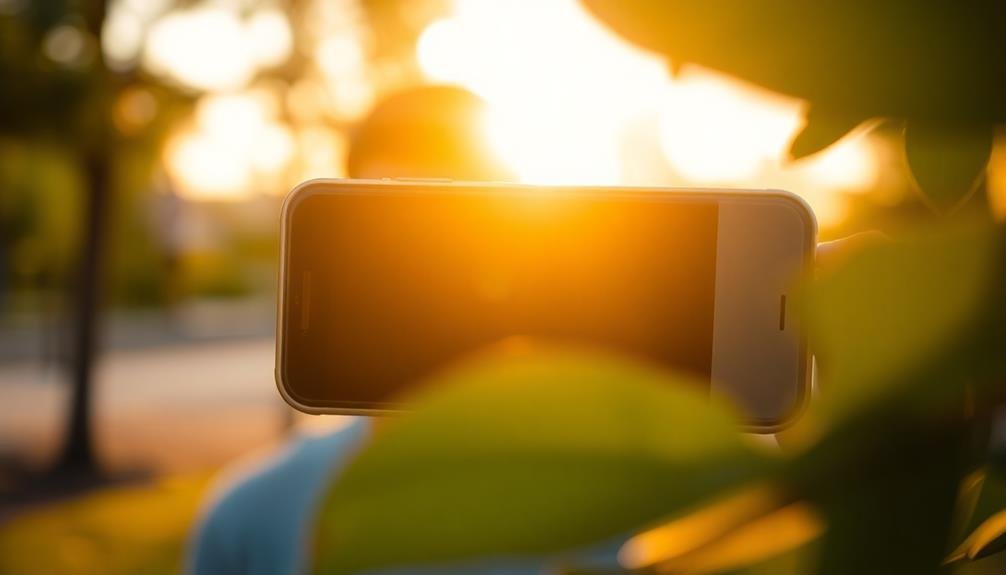To capture stunning portrait mode photos, start by choosing a simple, uncluttered background that complements your subject. Adjust the depth control settings to achieve the desired blur effect, experimenting with f-numbers for natural or dramatic separation. Play with lighting conditions, utilizing natural light or creative indoor options for unique effects. Position your subject effectively, using the rule of thirds and encouraging relaxed poses that reflect personality. Finally, master focus and framing by ensuring sharp focus on the eyes and applying compositional techniques like leading lines. These pro tips will elevate your portrait photography, but there's always more to explore in the art of capturing enchanting images.
Find the Perfect Background

When choosing a background for portrait mode photos, simplicity is key. You'll want to select a setting that complements your subject without overpowering them. Look for clean, uncluttered spaces that won't distract from your main focus. Solid-colored walls, textured surfaces, or softly blurred natural environments can all work well.
Consider the color palette of your background and how it interacts with your subject's clothing and skin tone. Contrasting colors can make your subject pop, while complementary hues create a harmonious feel.
Pay attention to lighting as well – soft, diffused light often works best for portraits.
Don't be afraid to get creative with unusual locations. An interesting doorway, a patch of colorful flowers, or even a plain white wall can serve as excellent backdrops.
Just guarantee there's enough distance between your subject and the background to achieve that coveted bokeh effect.
Adjust Depth Control Settings

Once you've set up your shot with the perfect background, it's time to fine-tune your portrait mode settings. Most smartphones with portrait mode offer depth control, allowing you to adjust the level of background blur.
Start by tapping the depth control icon, usually represented by an "f" symbol. Experiment with different blur levels to find the right balance. A higher f-number creates less blur, while a lower f-number increases the effect.
For a subtle, natural look, aim for an f-number between f/2.8 and f/4. If you want a more dramatic separation between subject and background, try f/1.4 or f/1.8.
Consider your subject's distance from the background when adjusting depth control. If they're close to the background, use less blur to maintain context. For subjects farther from the background, increase the blur for a more striking effect.
Don't forget to check the edges of your subject for any artificial-looking blurring. If you notice issues, slightly reduce the blur intensity or reposition your subject.
Experiment With Lighting Conditions

For stunning portrait mode photos, lighting is your secret weapon. The right illumination can enhance depth, highlight features, and create enchanting moods.
Don't settle for standard lighting; instead, experiment with various conditions to elevate your portraits.
Natural light often produces the most flattering results. Position your subject near a window or in soft outdoor light during the golden hour.
If you're shooting indoors, try different artificial light sources to create unique effects. Use lamps, fairy lights, or even your phone's flashlight to add drama and dimension.
To master portrait mode lighting, consider these techniques:
- Backlighting: Place your subject in front of a light source for a dreamy, ethereal effect
- Side lighting: Illuminate one side of the face to create depth and shadows
- Rembrandt lighting: Position the light at a 45-degree angle for a classic, artistic look
- Split lighting: Light half the face for a dramatic, high-contrast portrait
- Butterfly lighting: Place the light source above and slightly in front of your subject for a flattering glow
Position Your Subject Effectively

The key to enchanting portrait mode photos lies in how you position your subject. Start by placing them slightly off-center, using the rule of thirds to create a more visually appealing composition.
Experiment with different angles – try shooting from slightly above or below your subject to add interest and dimension.
Consider the background when positioning your subject. Look for clean, uncluttered areas that won't distract from your main focus. If possible, create some distance between your subject and the background to enhance the depth-of-field effect.
Pay attention to your subject's pose and body language. Encourage natural, relaxed positions that reflect their personality. For a more dynamic shot, have them turn their body slightly away from the camera while keeping their face towards you.
Don't forget about hand placement – hands can add expression and tell a story. Guide your subject to place their hands in natural, comfortable positions that complement the overall composition.
Lastly, verify your subject's eyes are in sharp focus. Direct them to look slightly off-camera for a candid feel, or straight into the lens for a more engaging portrait.
Master Focus and Framing

Mastering focus and framing is essential for creating stunning portrait mode photos. When using portrait mode, your camera automatically blurs the background, emphasizing your subject. To make the most of this effect, guarantee your subject's face is sharp and well-defined.
Experiment with different focal points, such as the eyes or the entire face, to see what works best for each shot.
Framing your subject is equally important. Consider the rule of thirds, placing your subject off-center for a more dynamic composition.
Don't be afraid to get creative with your framing:
- Use natural frames like doorways or arches
- Incorporate leading lines to draw attention to your subject
- Play with negative space to create a minimalist look
- Experiment with unusual angles for a unique perspective
- Try symmetrical compositions for a bold, striking effect
Remember to leave enough space around your subject to allow the bokeh effect to shine.
Pay attention to the background, even though it'll be blurred, as distracting elements can still impact the overall image.
Frequently Asked Questions
Can Portrait Mode Be Used for Non-Human Subjects?
Yes, you can use portrait mode for non-human subjects. It's great for pets, plants, and objects. You'll get that same blurred background effect, making your subject stand out beautifully. Experiment with different subjects to see what works best.
How Do I Enable Portrait Mode on My Specific Smartphone Model?
You'll need to check your smartphone's specific camera app. Look for a "Portrait" or "Depth" mode option. If you can't find it, consult your phone's user manual or search online for your model's instructions.
Are There Any Third-Party Apps That Enhance Portrait Mode Capabilities?
You'll find several third-party apps that enhance portrait mode. Try FocosPro, Snapseed, or Lightroom for advanced editing. These apps offer features like depth adjustment, bokeh effects, and selective focus to improve your portrait shots.
What's the Difference Between Portrait Mode and Regular Camera Mode?
You'll notice portrait mode blurs the background, focusing on your subject, while regular mode captures everything in focus. Portrait mode creates a depth effect, making your subject pop, but regular mode offers a wider field of view.
Can I Edit Portrait Mode Photos After They've Been Taken?
Yes, you can edit portrait mode photos after they've been taken. You'll find options to adjust blur intensity, lighting effects, and other parameters. Most smartphone photo editing apps offer specific tools for refining portrait mode shots.
In Summary
You've now got the tools to take your portrait mode photos to the next level. Remember, it's all about experimenting and finding what works best for each shot. Don't be afraid to play with backgrounds, lighting, and subject positioning. Adjust your depth control settings and focus carefully for that perfect blur. With practice, you'll be capturing stunning portraits that'll make your subjects and followers alike say "wow!" Keep shooting and refining your skills.





Leave a Reply